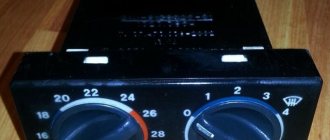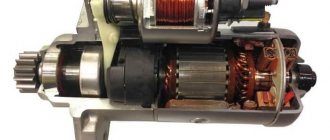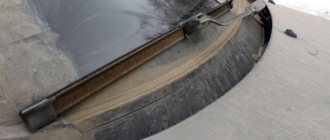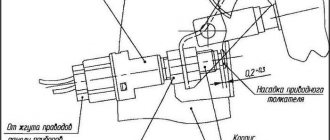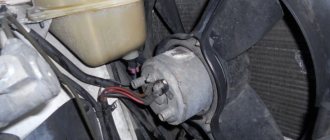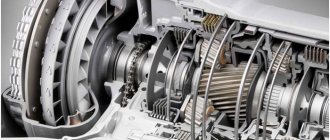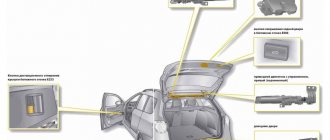All electrical circuits of the car are equipped with protection against short circuits and overloads. Troubleshooting the on-board network or equipment is closely related to finding out the causes of blown fuses in the car. Postponing the solution to the problem until later and simply replacing an unusable part can lead to failure of expensive equipment and even fire.
General information about fuses in the car
Protecting electrical equipment with fusible inserts located in separate blocks is the simplest and cheapest means of maintaining the functionality of electrical devices. They are most effective in ensuring the safe operation of equipment due to their low cost and ease of use.
Long-term operation of fuses is possible if:
- inspect the most dangerous, worn-out areas of on-board wiring in order to find a malfunction;
- avoid short circuits;
- avoid prolonged overloads of the vehicle’s electrical components;
- do not exceed the load capacity of the generator or battery;
- maintain moving mechanisms and components in good condition.
Following these rules will allow you to resort to replacing fuses less often.
Purpose and functions
Fuses are designed to protect electrical equipment and wiring from damage. Their main function is to disconnect the consumer from the power source by self-destruction if the value of the flowing current exceeds the set threshold.
Main types
The fuses used in cars differ in how they disconnect consumers:
- fuse link;
- electromechanical device (relay);
- electronic device (transistor, thyristor).
The last 2 options may have automatic restoration of power supply after the fault is eliminated.
Main types of protective devices:
- cylindrical;
- knife (mini, standard, maxi formats);
- thermal (with thermal and electromagnetic protection) and manual restoration of the electricity supply;
- tape, for high-current circuits.
Location
The blocks are located in protected but easily accessible places. They are grouped by functionality. Under the hood, next to the battery, there are parts for the starting system, lighting, and side lights.
Blocks related to multimedia, air conditioning systems, and interior lighting are located at the end of the left side of the dashboard or under the side sheet, on the driver’s side.
Main causes of burnout
Insurance companies collecting statistics have found that over 90% of all car fires are caused by faulty on-board wiring and the use of poor quality fuses or “bugs”.
Possible causes of burnout are:
- short circuit (short circuit) directly in the load (consumer);
- Short circuit in the wiring caused by insulation failure and short circuit to the housing;
- increasing the voltage of the on-board network;
- using the wrong denomination;
- poor connection with the contacts of the block;
- physical and chemical wear.
Short circuit in the electrical circuit
More often than other reasons, the fuse link burns out due to a short circuit. The resistance of the electrically conductive section decreases greatly, and the current increases tens or hundreds of times. This situation leads to:
- violations of wiring insulation due to strong heating;
- water entering unprotected live areas;
- mechanical damage to components;
- incorrect load connection.
Exceeding the permissible current limit
An increase in current strength above the permissible limit differs from a short circuit in the nature of the increase and the duration of the effect. This situation leads to:
- connecting a load exceeding the calculated value;
- consumer work in difficult conditions, for example, pulling out a car stuck in mud with an electric winch.
Poor connection to the block
Unreliable contact with the block leads to the formation of sparks in this place, excessive heating of the material and burnout of the fusible insert. Occurs when using parts of unsatisfactory quality, the thickness of the legs is less than normal or the contact group has lost its springy properties.
Wear
This process is primarily caused by oxidative processes and atmospheric influences. Over time, corrosion destroys the insert material, contacts are broken, which leads to interruption of power supply to consumers.
Violation of the current supply path in the circuit
The current strength in the circuit is calculated in advance and does not exceed the specified values if the equipment is in working order. However, mechanical damage to wires, contacts, and insulation failures for various reasons change the load value and affect the distribution of current in the circuit.
Disturbances in the flow path in most cases lead to an increase in current strength.
Wrong fuse selected
By mistake, a fuse with a lower rating may be installed instead of the standard one. Then, even with working equipment, the amount of current flowing will exceed the limit value of the part used, and the fuse-link will soon burn out.
Examination
First of all, the electrical circuit “rings” to the housing. In this case, the battery terminals are disconnected. It must be remembered that the second wire from the engine goes to the housing; it must have zero contact resistance. The supply conductor is checked for short circuit.
If the wiring is intact, proceed to checking the voltage of the electrical circuit assembly. Measuring points are determined according to the diagram in the car manual. Also, the power at the battery terminals must be at least 12 V when the engine is off. When operating, a value above 13.6 V is measured.
With a multimeter you can measure resistance, contact integrity, and check voltage. The presence of oxides or mechanical damage is determined visually.
Self-diagnosis
Sooner or later the driver will have to deal with replacing blown fuses. First of all, this applies to fans of sports driving and off-road rallies. In these modes, electrical equipment operates at the limit of permissible parameters with an increased current load, which often leads to the destruction of fuse links. Suitability for work can be assessed visually, making sure of their integrity, or using a tester (multimeter) to check the conductivity.
The main rule for replacement is to install a part with the same operating current rating that was used before. If there is no choice, the deviation should not exceed 30% of the standard value.
Visual inspection
The body of the parts is deliberately made of transparent material and breakage, spraying, and other cases of damage are determined by the naked eye. You should immediately pay attention to the integrity of the fuse link. Next, traces of melting of the plastic case are looked for. A faulty part may be indicated by traces of thermal or spark effects on the contacts.
Using a multimeter
The examination does not guarantee a reliable result. Testing with instruments is more informative. The multimeter allows you to resolve doubts in difficult situations by showing the resistance value. If the fuse is working properly, no voltage will be detected at its ends, and if there is a malfunction, the voltmeter will show the value of the on-board network.
To determine the integrity of the fuse, a tester is not required; a probe or a light bulb is sufficient. If the part is working properly, they will not show anything. If the fuse is blown, the light will come on.
Actions in case of problems
If a fuse is blown, do not immediately change it and try to turn on the electrical equipment. You should check the wiring and connected devices for obvious visible damage, signs of burning, melting, including the location of the fuse. If after replacement it burns out again, continue searching for the fault that causes it to operate.
Repair
If a faulty unit is detected that causes a fuse to blow, it should be disconnected from the on-board network and, at the first opportunity, have it repaired by an electrician or replaced. It is not worth repairing the fuses themselves, as this can lead to serious consequences, including a fire in the car. It is better to categorically refuse to use “bugs” (homemade fuses).
Replacement
When replacing a fuse, the likelihood of error increases due to the same size of parts, differing only in color. Product labeling is not always visible. Therefore, when changing low-current fuses, you should be careful not to install a more powerful option.
Nuances of solving problems on the road
When setting off on the road, you should prepare a supply of fuses that caused complaints when the car was operating. To speed up the replacement of parts on the road, draw up in advance a diagram of the location in the mounting block, the purpose and indicate the denominations on the map.
Answers@Mail.Ru: Microwave knocks out plugs
The wiring is acting up
So, no microwave. Knocks out due to a short circuit. The plug, cord, and maybe even the power supply circuit in the microwave itself was damaged. Happens. Bring it in for repair.
There was something wrong with the power cable, it got crushed somewhere. The microwave itself is fine.
Why constantly unplug it? Our washing machine also knocks out plugs because the load is heavy. Unplug the TV from this outlet and the refrigerator, turn off the lights and go ahead. Don't forget to check the socket and plug for overheating.
Try turning off the plugs, plugging in the microwave and then try turning on the plugs. If the plugs do not turn on, but immediately knock out, the microwave will be repaired.
Invite a specialist, don’t do the experiments yourself!
There is a fuse in the microwave, theoretically, if there is a short circuit in the oven, it should blow out. It looks like there is a short somewhere in the cord or plug. It’s better to contact an electrician you know, let him call and check.
along the way - the cord is crushed... in the microwave - there is a 6 amp fuse... it would have died..
Most likely you have an RCD and it turns off, that’s how it should be
I have encountered this in my practice. One of the microswitches on the door was faulty (I don’t remember which one exactly). There are 200 volts everywhere. After replacing it, everything went well.
touch.otvet.mail.ru
Tips for choosing a quality fuse for your car
It is recommended to select fuses for the car taking into account the following recommendations:
- buy products from familiar brands whose quality you are confident in;
- follow the same approach when choosing a place of purchase, so that the seller always offers original products and not superficially similar parts of unknown origin;
- pay attention to the thickness or width of the fusible insert, which is the same for all denominations - fake;
- if, despite all the signs, there are doubts about the quality of the fuses, test one of them with a short circuit by connecting it to the battery (it should burn out as soon as possible).
The fuse must not have high resistance, cause excessive power loss, or interfere with the operation of the equipment. At the same time, to reliably perform protective functions, the insert should not be massive in order to be able to disconnect the load from the power source in a short period of time.
The listed parameters contradict each other, and an acceptable ratio has been achieved in products of brands that have been on the market for a long time. Keep a supply of fuses of various ratings in your vehicle at all times.
Short circuits
This is one of the serious reasons. If bare wires of opposite polarities come into contact in any way, a short circuit will occur. For this reason, the stove fuse often blows. And it will burn until the owner replaces or insulates the damaged wires.
Short circuits can occur in any part of the vehicle's electrical system. Many people complain that the fuse that protects the cigarette lighter fails. The first thing you should do is not disassemble the connector, take it out and go for a new one. Everything could be much simpler.
If the cigarette lighter fuse has blown, then the problem may be due to the high power of the device that is connected to this cigarette lighter. It may also be a matter of the quality of contacts. Often, the adapters are Chinese, and the quality of the contacts in them is very low. It is recommended that before using radical measures, you first carefully examine the design of the cigarette lighter and find the weak point. Usually there are such places - a short circuit can easily occur in them. It is necessary to carefully inspect the contacts and, if possible, somehow insulate them. Usually, after the weak point is found and the cause of the short circuit is solved, the cigarette lighter fuse no longer blows.
